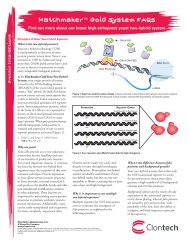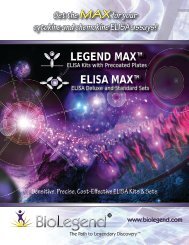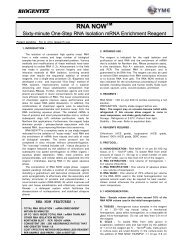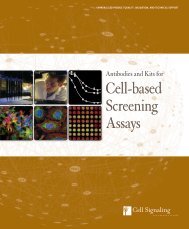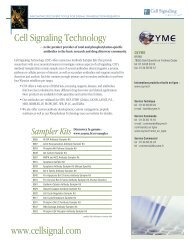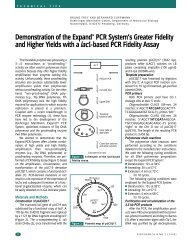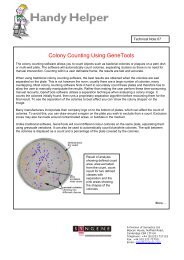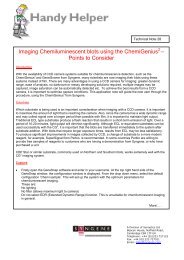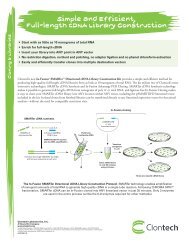DNA polymerase fidelity and the polymerase chain reaction. - Ozyme
DNA polymerase fidelity and the polymerase chain reaction. - Ozyme
DNA polymerase fidelity and the polymerase chain reaction. - Ozyme
Create successful ePaper yourself
Turn your PDF publications into a flip-book with our unique Google optimized e-Paper software.
Downloaded from genome.cshlp.org on October 11, 2011 - Published by Cold Spring Harbor Laboratory Press<br />
not in large excess over <strong>the</strong> total concentration<br />
of dNTP substrates, <strong>and</strong> be<br />
buffered to -pH 6 (70~ using Bis-Tris<br />
Propane or PIPES (Table 2). These buffers<br />
have a pK a between pH 6 <strong>and</strong> pH 7<br />
<strong>and</strong> a small temperature coefficient<br />
(ApKa/~ allowing <strong>the</strong> pH to be<br />
maintained stably throughout <strong>the</strong> PCR<br />
cycle.<br />
For amplifications in which <strong>fidelity</strong><br />
is <strong>the</strong> critical issue, one should avoid<br />
<strong>the</strong> concept that conditions generating<br />
more <strong>DNA</strong> product are <strong>the</strong> better conditions.<br />
Reactions that optimize <strong>fidelity</strong><br />
may be relatively inefficient for<br />
amplification. The total number of<br />
cycles should be kept to <strong>the</strong> minimum<br />
necessary to produce a feasible amount<br />
of product <strong>DNA</strong> for <strong>the</strong> desired use.<br />
Thus, although using low pH, low<br />
Mg 2+, <strong>and</strong>/or a low concentration of<br />
dNTPs may not produce an impressive<br />
amount of amplification product as<br />
visualized on an ethidium bromide<br />
stained-agarose gel, <strong>the</strong>se conditions<br />
may provide an adequate amount of<br />
<strong>DNA</strong> for cloning purposes. Using a<br />
small number of cycles will also minimize<br />
<strong>the</strong> contribution of mutations<br />
resulting from <strong>DNA</strong> damage at high<br />
temperature. The <strong>DNA</strong> sequence of<br />
several independent clones from <strong>the</strong><br />
final PCR population should be determined<br />
to verify that <strong>the</strong> original <strong>DNA</strong><br />
sequence has been maintained during<br />
<strong>the</strong> amplification process. Ideally, <strong>the</strong><br />
clones should be derived from separate<br />
PCR experiments to minimize <strong>the</strong> risk<br />
of overrepresentation of early polymeruse<br />
errors.<br />
The <strong>fidelity</strong> of <strong>DNA</strong> syn<strong>the</strong>sis in<br />
vitro is limited by <strong>the</strong> least accurate<br />
<strong>reaction</strong> that occurs. For example, <strong>the</strong><br />
T~ mispair is one of <strong>the</strong> most frequently<br />
produced <strong>and</strong> most easily extended<br />
base substitution error.(35) Even<br />
under high-<strong>fidelity</strong> <strong>reaction</strong> conditions,<br />
most of <strong>the</strong> Taq <strong>polymerase</strong> errors<br />
were <strong>the</strong> result of T~ mispairs<br />
that led to A'T~G'C transitions.(13)<br />
Therefore, <strong>the</strong> upper limit for Taq <strong>polymerase</strong><br />
<strong>fidelity</strong> will be <strong>the</strong> frequency<br />
with which <strong>the</strong> enzyme creates this<br />
mispair. In general, this limitation is<br />
not restricted to a particular mispair.<br />
The sequence of <strong>the</strong> target <strong>DNA</strong> will<br />
have a profound influence on <strong>the</strong> generation<br />
of mutations. Thus, <strong>the</strong> least<br />
accurate <strong>reaction</strong> may be <strong>the</strong> result of<br />
an exceptionally high error rate at a<br />
particular nucleotide sequence, since<br />
<strong>the</strong> phenomenon of "hot spots" for<br />
polymerization errors has been clearly<br />
established.(16)<br />
ACKNOWLEDGMENTS<br />
We are grateful to Drs. Theodora<br />
Devereux <strong>and</strong> Neal Cariello for helpful<br />
comments <strong>and</strong> critical evaluation of<br />
<strong>the</strong> manuscript. We would also like to<br />
thank Drs. Myron Goodman, William<br />
Thilly, Lucy Ling, Pekka Mattila, <strong>and</strong><br />
Neal Cariello for providing results prior<br />
to publication.<br />
REFERENCES<br />
1. Lacy, M.J., L.K. McNeil, M.E. Roth,<br />
<strong>and</strong> D.M. Kranz. 1989. T-Cell receptor<br />
g-<strong>chain</strong> diversity in peripheral<br />
lymphocytes. Proc. Natl. Acad. Sci. 86:<br />
1023-1026.<br />
2. Frohman. M.A., M.K. Dush, <strong>and</strong> G.R.<br />
Martin. 1988. Rapid production of<br />
full-length c<strong>DNA</strong>s from rare<br />
transcripts: Amplification using a<br />
single gene-specific oligonucleotide<br />
primer. Proc. Natl. Acad. Sci. 85:<br />
8998-9002.<br />
3. Li. H., X. Cui, <strong>and</strong> N. Arnheim. 1990.<br />
Direct electrophoretic detection of<br />
<strong>the</strong> allelic state of single <strong>DNA</strong><br />
molecules in human sperm by using<br />
<strong>the</strong> <strong>polymerase</strong> <strong>chain</strong> <strong>reaction</strong>. Proc.<br />
Natl. Acad. Sci. 87: 4580-4584.<br />
4. Jeffreys, A.J., R. Neumann, <strong>and</strong> V.<br />
Wilson. 1990. Repeat unit sequence<br />
variation in minisatellites: A novel<br />
source of <strong>DNA</strong> polymorphism for<br />
studying variation <strong>and</strong> mutation by<br />
single molecule analysis. Cell 60:<br />
473-485.<br />
5. Ruano, G., K.K. Kidd, <strong>and</strong> J.C.<br />
Stephens. 1990. Haplotype of<br />
multiple polymorphisms resolved by<br />
enzymatic amplification of single<br />
<strong>DNA</strong> molecules. Proc. Natl. Acad. Sci.<br />
87: 6296-6300.<br />
6. Dunning, A.M., P. Talmud, <strong>and</strong> S.E.<br />
Humphries. 1988. Errors in <strong>the</strong><br />
<strong>polymerase</strong> <strong>chain</strong> <strong>reaction</strong> Nucleic<br />
Acids Res. 16: 10393.<br />
7. Saiki, R.K., D.H. Gelf<strong>and</strong>, S. Stoffel,<br />
S.J. Scharf, R. Higuchi, G.T. Horn,<br />
K.B. Mullis, <strong>and</strong> H.A. Erlich. 1988.<br />
Primer-directed enzymatic amplification<br />
of <strong>DNA</strong> with a <strong>the</strong>rmostable<br />
<strong>DNA</strong> <strong>polymerase</strong>. Science 239:<br />
487-491.<br />
8. Newton, C.R., N. Kalsheker, A.<br />
Graham, S. Powell, A. Gammack, J.<br />
Riley, <strong>and</strong> A.F. Markham. 1988.<br />
Diagnosis of ~l"antitrypsin deficiency<br />
by enzymatic amplification of human<br />
genomic <strong>DNA</strong> <strong>and</strong> direct sequencing<br />
of <strong>polymerase</strong> <strong>chain</strong> <strong>reaction</strong><br />
products. Nucleic Acids Res. 16:<br />
8233-8243.<br />
9. Vrieling, H., M.L. Van Roooijen, N.A.<br />
Groen, M.Z. Zdzienicka, J.W. Simons,<br />
P.H. Lohman, <strong>and</strong> A.A. Van Zeel<strong>and</strong>.<br />
1989. <strong>DNA</strong> str<strong>and</strong> specificity for UVinduced<br />
mutations in mammalian<br />
cells. Mol. Cell. Biol. 9" 1277-1283.<br />
10. Ennis, P.D., J. Zemmour, R.D. Salter,<br />
<strong>and</strong> P. Parham. 1990. Rapid cloning<br />
of HLA-A,B c<strong>DNA</strong> by using <strong>the</strong> <strong>polymerase</strong><br />
<strong>chain</strong> <strong>reaction</strong>: Frequency <strong>and</strong><br />
nature of errors produced in amplification.<br />
Proc. Natl. Acad. Sci. 87:<br />
2833-2837.<br />
11. Loh, E.Y., J.F. Elliott, S. Cwirla, L.L.<br />
Lanier, <strong>and</strong> M.M. Davis. 1989. Polymerase<br />
<strong>chain</strong> <strong>reaction</strong> with singlesided<br />
specificity: Analysis of T-ceU<br />
receptor ~ <strong>chain</strong>. Science 243:<br />
217-220.<br />
12. Goodenow, M., T. Huet, W. Saurin, S.<br />
Kwok, J. Sninsky, <strong>and</strong> S. Wain-<br />
Hobson. 1989. HIV-1 isolates are<br />
rapidly evolving quasispecies:<br />
Evidence for viral mixtures <strong>and</strong><br />
preferred nucleotide substitutions. J.<br />
Acquired Immune Defic. Syndr. 2:<br />
344-352.<br />
13. Eckert, K.A. <strong>and</strong> T.A. Kunkel. 1991.<br />
The <strong>fidelity</strong> of <strong>DNA</strong> <strong>polymerase</strong>s used<br />
in <strong>the</strong> PCR. In Polymerase <strong>chain</strong><br />
<strong>reaction</strong> I: A practrical approach (eds.<br />
M.J. McPherson, P. Quirke, <strong>and</strong> G.R.<br />
Taylor). IRL Press at Oxford University<br />
Press, Oxford. (In press.)<br />
14. Reiss, J., M. Krawozak, M. Schloesser,<br />
M. Wagner, <strong>and</strong> D.N. Cooper. 1990.<br />
The effect of replication errors on <strong>the</strong><br />
mismatch analysis of PCR-amplified<br />
<strong>DNA</strong>. Nucleic Acids Res. 18" 973-978.<br />
15. Luria, S.E. <strong>and</strong> M. Delbruck. 1943.<br />
Mutations of bacteria from virus<br />
sensitivity to virus resistance. Genetics<br />
28" 491-511.<br />
16. Kunkel, T.A. 1990. Misalignmentmediated<br />
<strong>DNA</strong> syn<strong>the</strong>sis errors.<br />
Biochemistry 29:8003-8011.<br />
17. Ripley, L.S. 1990. Frameshift<br />
mutation: Determinants of specificity.<br />
Annu. Rev. Genet. 24: 189-213.<br />
18. Streisinger, G., Y. Okada, J. Emrich, J.<br />
Newton, A. Tsugita, E. Terzaghi, <strong>and</strong><br />
M. Inoye. 1966. Frameshift mutations<br />
<strong>and</strong> <strong>the</strong> genetic code. Cold Spring<br />
PCR Methods <strong>and</strong> Applications 23



